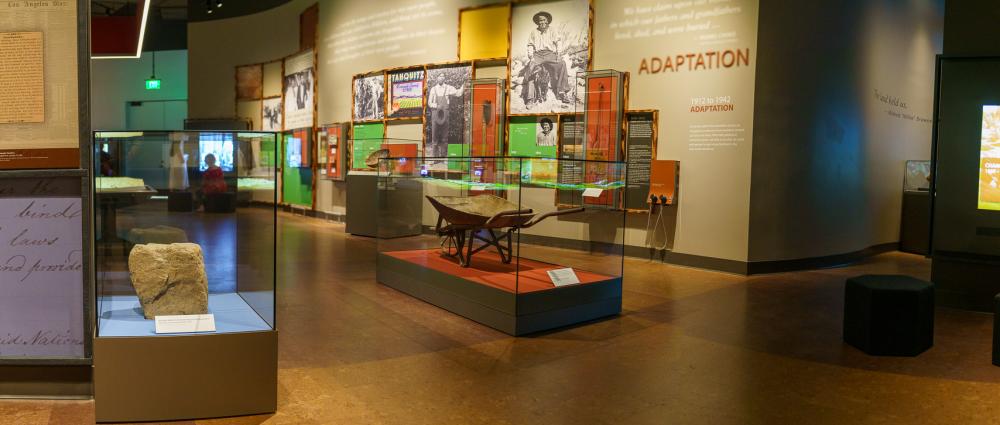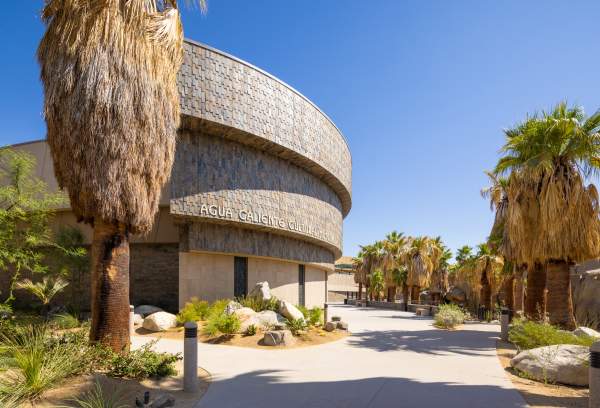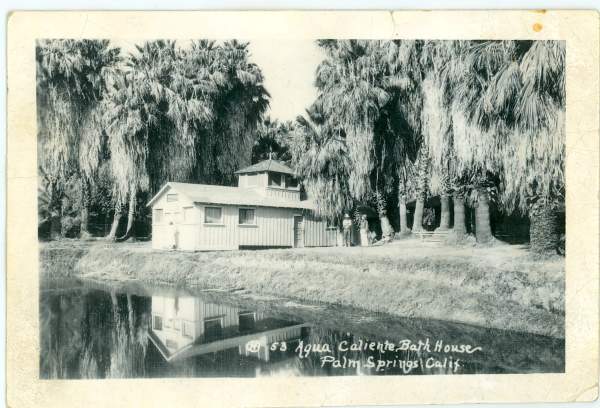Connecting the Past and Present
A visit to the Agua Caliente Cultural Museum begins with the words, “Welcome to Our Home.” Almost 48,000 square feet of permanent exhibit space on a 5.8-acre complex is dedicated to the Tribe’s collection of art and artifacts and a 360-degree animation theater telling the creation story.
The Agua Caliente Cultural Plaza includes the Cultural Museum with an education garden and The Spa at Sec He, a state-of-the-art spa fed by the ancient Agua Caliente Hot Mineral Spring. It is joined by the Gathering Plaza and Oasis Trail, which is activated with flowing water, Washingtonia filifera palm trees (the only palm tree native to the California desert), and stunning rock formations that capture the essence of the Indian Canyons and Tahquitz Canyon, which are the ancestral homes of the Agua Caliente people.
While the Plaza connects ancient and contemporary life, the Oasis Trail reflects the canyons' sequestered nature. The water-filled areas provided by the Agua Caliente people offer cooler living conditions in the hot desert summers.

Setting The Foundation
Your journey will begin with an education of the creation story.
The Cahuilla people share a creation story that began with two nights, representing a man and a woman. With a flash of lightning, twin boys were born. They were alone, so the brothers created companions made of people from Earth. The one brother made his people much faster than the other brother did. He could not understand how, so he made the sun in order to see. It would fall to earth, but by the following day, it would rise again.
When the sun fell, it became dark, so they created the moon. The moon was a woman, bright and beautiful. Her name was the Moon Maiden. To make more light, they blew stars into the sky.
This introductory theater-in-the-round contains crescent-shaped benches for comfortable viewing. Once you have gained this foundational context, you will embark on a cultural journey through various art forms and narratives.

Cultural Journey
The next exhibit area highlights the Indian Canyons, comprising Indian Canyon, Andreas Canyon, and Palm Canyon. It also includes information on Tahquitz Canyon and Chino Canyon. In addition to harboring flora and fauna that are historically and culturally significant to the Agua Caliente, these ancestral lands directly influenced how the Tribe’s clan structure evolved.
From here, you will continue through the gallery, which features many elements of Agua Caliente's artistic expressions and material culture. This will include ceremonial practices and objects such as baskets and ollas (clay vessels used for seeds, food, and water). Audio and video explain how and why the Agua Caliente changed, adapted, and embraced self-determination. You will also learn the significance behind Séc-he, the Agua Caliente Hot Mineral Springs.

By the time you reach the fourth exhibit area, you will have arrived at the most linear part of the permanent gallery, where a visual timeline and digital map table display the Agua Caliente’s focus on the arrival of Euro-American settlers in the 19th century.
The final exhibit area highlights archaeology. This includes many artifacts discovered during construction, such as manos, metates, and projectile points dating as far back as 8,000 years.
Another section of the museum will feature rotating exhibits, classrooms, a meeting space, and a film screening room. Outside is a native plant garden where visitors can learn about traditional food sources, medicine, and shelter.

The Tribe’s Voice
The Agua Caliente Cultural Museum is the Tribe’s voice. It’s their story, and it’s being told the way they want it told. It focuses on elements that they believe are important. In keeping with this, members’ stories will appear throughout the permanent exhibition.
Before leaving, you will encounter a crescent-shaped room housing five large monitors featuring first-person video narratives. The person is always a Tribal member talking about who they are and why being a member of the Agua Caliente community is essential.
Explore the Rich Heritage of the Agua Caliente Cahuilla Indians
Agua Caliente Hot Mineral Springs – A Story of Healing
Agua Caliente Hot Mineral Springs: A Sacred Legacy of Healing & Culture
Section 14: The Untold Story of Palm Springs' Heart and Heritage
- 14 min read
A Story of Community, Resilience, and Renewal on Tribal Land What Was…
Breaking the Glass Ceiling - Big Time!
- 8 min read
How the Agua Caliente Tribe’s All-Woman Council Changed Palm…
Agua Caliente Hot Mineral Springs: A Sacred Legacy of Healing & Culture
- 4 min read
The History The Agua Caliente Band of Cahuilla Indians has been…
Discover the Best Spas in Palm Springs
- 4 min read
Unwind and Rejuvenate with these Luxury Treatments Relax and replenish…
The Untold Stories Behind Palm Springs Street Names
- 8 min read
Discover the Meaning Behind Palm Springs Street Names Vista Chino…




